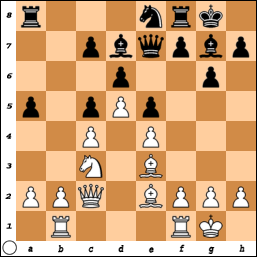Playing the tournament was therefore a rather risky business because not passing the examination would have implied an additional term until graduation. In spite of the limited preparation time, I have just walked away with a mark of 1.7 (i.e. B+ in Anglo-Saxon vicinities), which is an absolutely fantastic result. Now I'm sitting in the cafeteria, having a bottle of Victory beer, as is custom amongst students after examinations. Then I'll continue writing my next to last thesis, which should be finished within a month, followed by my final thesis and graduation by late autumn.
So this explains the first part of the title, but what about the Shadow? Well, after having led the league by one point until the 9th and last round last Sunday, my team lost the deciding match against the last remaining contenders SC Heusenstamm, who thus overtook us right before the finishing line.
It was a very close match in which Heusenstamm, who were actually the favourites, had the better start, with several of my team mates having been pressed into defensive positions. After it became clear that some games were promising for our opponents, I got offered a draw in the following position:
Uwira, O. (2240) - Solonar, S. (2338)

The position is actually quite promising for White because it's easy to break up the barricades on the queenside. However, a plan must be found with regard to the defensive setup on the kingside, as Black is of course planning to initiate the typical King's Indian attack. Basically, White has three options once the Black f-pawn reaches f5:
- Simply answer f2-f3 and allow f5-f4: this counts on being faster on the queenside and actually seems to be the most promising option. The point is that in the usual queenside attack White only has c7 at his disposal for invading with his heavy pieces. Here there White will most likely have b7 and c7.
- Take on f5 and play f2-f3: White will restrain the Black pawn center and effectively forces Black to sacrifice a pawn by e5-e4 at some point. White will still play on the queenside and the will not be slow.
- Take on f5 and play f2-f4: this restrains the Bd7 and marks the f5 pawn as either a target for direct attack or as an anchor for the lever g2-g4 once some pieces have been exchanged. However, this doesn't really work here, because Black's pawn on c5 covers the d4-square, which is normally used as a hub by White's pieces once Black has committed e5-e4 in this structure.
So you see, now, after I have analysed a bit, I sort of know what is going on, but during the game I was busy with determining the chances of my team mates, trying to decide whether to accept the draw offer or not. Thus I spend ten minutes watching the other positions, sat down for 10 minutes thinking about the position, got up again to have a final look at the other boards, and then sat down again.
I wanted to accept the draw, but that seemed to be ill-advised, given that some positions at the other boards really looked very dangerous for us. So I played on, knowing that the chance to draw would not return, and moreover, I also followed the worst of the three above-mentioned plans...
15.a3 f5 16.exf5!? I now believe that it is best to just play 16.f3. 16...gxf5 17.f4? As explained, this is only playable if White will have d4 at his disposal once Black has played e5-e4. 17...Nf6 18.Rbe1(?) e4! Well, now the rook at e1 looks silly but I already had to defend against stuff like Ng4 or Ne4.
I'll omit the rest of the game here because it was both brutal and straightforward. With a tougher defense I might have saved the game, but as my time was running out I lost the big picture and got knocked out along the g-file. In the end we lost the close struggle with 3.5-4.5 and came in as runner-ups, which wins us the crap medal.
Thus I lost that game because of a gross strategical misjudgement, which is a pity because I could have actually known what to do if I had had some time to prepare. But here we're back to Light - at least I've passed my exam. I'll probably be playing chess all my life but I certainly don't want to stay at the university for much longer.


Sommerpause? Sehr ruhig ist es hier leider geworden. Gibt es evtl. einen Bericht zum aktuellen Turnier in Bad Homburg? Und sah das Turmendspiel (und zuvor auch das Mittelspiel)in der 5. Runde nicht sehr gewinnträchtig aus? Was hat z.B. gegen Txd4 gesprochen?
ReplyDeleteViel Erfolg für die letzten zwei Runden.
Momentan hab ich leider viel andere Schreiberei am Hals... Studienarbeit, Vereinszeitung usw...
ReplyDeleteRe Runde 5: Wenn Du Txd4 anstatt f5+ meinst, das geht nicht wegen Th7 mit Remis. Später anstatt Lxd4? Hmm, ich war in Zeitnot und hab's bis jetzt noch nicht analysiert.
Gewonnen muss das aber auf jeden Fall gewesen sein. Mein Hauptverdächtiger für meinen Fehler ist mein h7-h5.
Dann habe ich Th7 übersehen. Dies ist der Unterschied zwischem dem Amateur als Kiebitz und dem Spieler am Brett :-) Gewonnen müsste die Partie aber auf jeden Fall gewesen sein...allein schon die Königszüge von Weiß im Mittelspiel gehören bestraft...
ReplyDelete